If you are a fan of autumn, then you are no stranger to the color orange. The color orange symbolizes determination, fascination, stimulation, creativity, encouragement, attraction, and success.
Orange flowers can inject color, cheer, and brightness into a garden or landscape. Then again, some of them are used for healing rashes, burns, and wounds, while others contain antioxidants.
In this article, we will discuss various types of orange flowers. So, if you are looking for an orange flower to brighten up your garden or cheer up a friend, this list can be your guide.
Table of Contents
Mountain Aloe

Mountain aloe has tube-shaped red-orange flowers that bloom on long stems above thick variegated leaves.
Mountain aloes are easy-to-grow succulents that can grow around 10 feet tall. They are best used as container plants since they do not tolerate frost.
Mountain aloes require a lot of sunlight to grow successfully. So, ensure you are careful when picking a spot to place your plant. They also prefer well-drained soil and do not require too much water.
Mountain aloes grow well in zones 8-11.
Alstroemeria
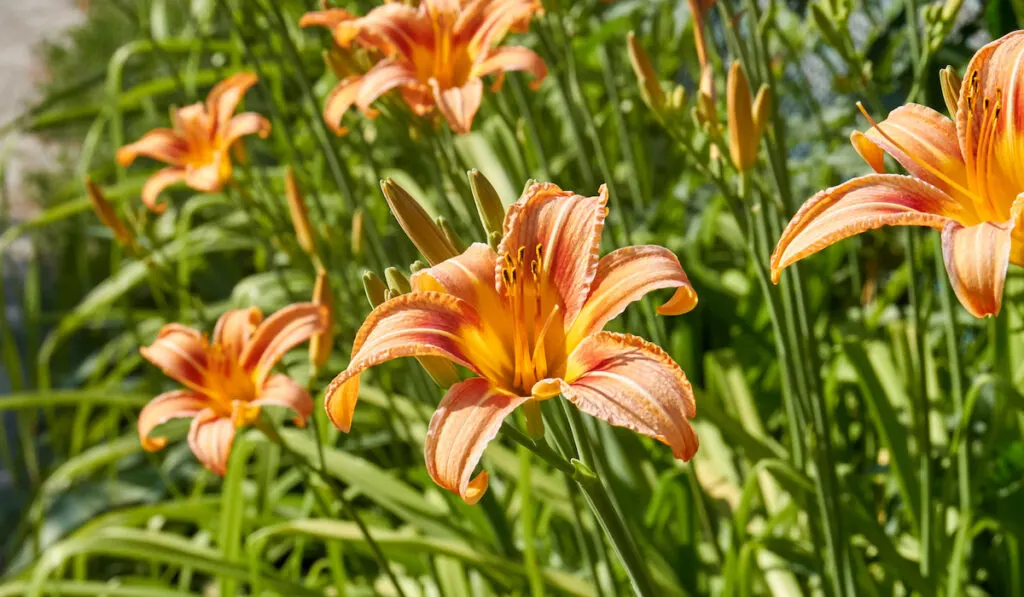
Alstroemeria is a tropical plant that produces three colorful blooms that come in an array of colors. The flowers have six petals that are either dotted, streaked, or stippled with dark pigmentation.
Alstroemerias symbolize mutual support and devotion. They are the perfect gift for a friend you wish to show encouragement.
Ideal growing conditions for Alstroemeria include well-drained soil and full sun or partial shade.
When planting Alstroemeria in your garden, ensure you pick a site with adequate shelter. Staking the plants is also necessary to prevent them from collapsing in rain or wind.
Alstroemerias grow best in zones 8-11.
Begonia

There are several varieties of Begonia. Most of them come with large-sized double orange, pink, yellow, red, and white flowers that bloom atop dark green leaves.
Some famous orange Begonia cultivars include ‘Picotee Sunburst,’ ‘Non-Stop Orange,’ and ‘Encanto Orange.’
Begonias represent gratitude and are popular among gardeners and floral enthusiasts. You can incorporate it into a gift wishing the receiver contentment, wealth, and happiness.
Begonias prefer rich, moist, well-drained soil with moderate sunlight exposure. They are prone to rot and mildew, especially in areas with high humidity. However, you can prevent this by spacing them in a way that promotes air circulation.
Begonias grow well in zones 6-11.
Bird of Paradise
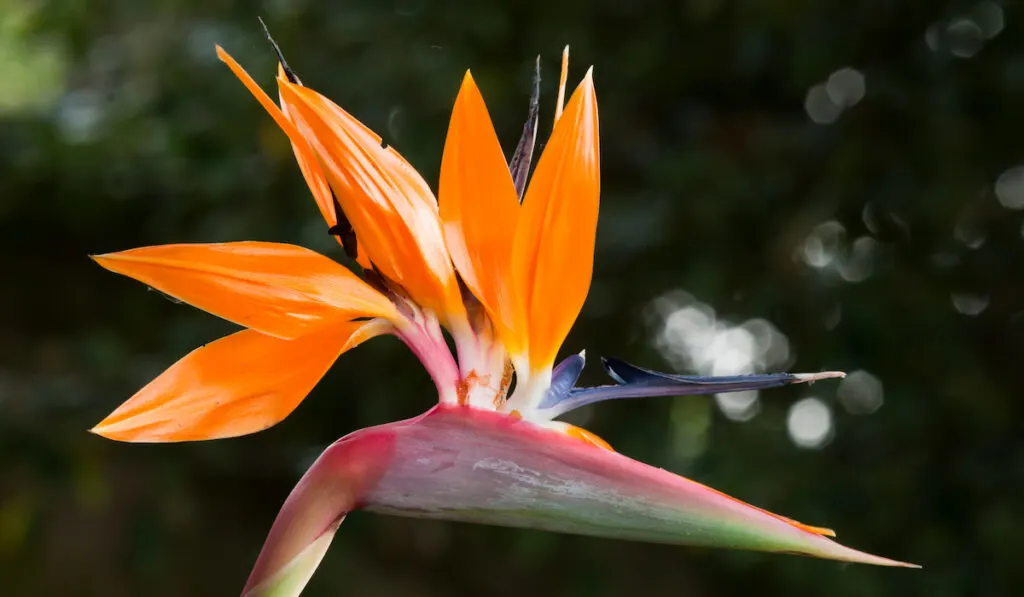
Bird of Paradise is a tropical plant famous for its unique crane-headed blooms and fan-like foliage. The flowers appear in a variety of colors, including orange, red and yellow. But the most common color is orange with blue accents.
Birds of Paradise make excellent indoor plants, but you can also grow them as potted plants. Since they are native to South Africa, they prefer full sun or partial shade and moist, well-drained soil for successful growth.
Bird of Paradise symbolizes thoughtfulness, faithfulness, and love. It is also the official flower for celebrating nine-year anniversaries.
Bird of Paradise thrives in zones 10-11.
Bulbine

Bulbines are beautiful succulents famous for their orange or yellow blossoms and grass-like foliage. Their bright colors make them excellent in containers and as mixed garden bed plants.
Bulbines require well-drained soil and regular but moderate watering. They grow best when exposed to full sun.
Bulbines tend to grow in clumps, with flower stalks growing to around 2 feet. When flowers die, remove them to encourage new blooms.
As a native of South Africa, bulbines are accustomed to heat and dry soils. They are best grown in zones 9-11, and if you reside in Florida, you should have no problem growing this plant.
Butterflyweed

Butterflyweed is a bushy perennial that produces clusters of bright orange or yellow flowers. It is also called the Chigger Flower or Butterfly Milkweed.
Butterflyweeds have waxy stems with long lance-shaped leaves. They can be used as border plants or for outdoor décor.
The bright orange flowers of Butterflyweeds have a sweet fragrance that attracts hummingbirds, bees, and butterflies. They grow best in dry, well-drained soil and full sun, and they do not need as much water as some other flowers on this list.
Butterflyweed grows well in zones 3-9.
California Poppies

California Poppies or the Flame Flower is an herbaceous perennial with bright orange, four-petal, cup-shaped flowers.
California Poppies are low maintenance. They can be used in containers or combined with other wildflowers in floral arrangements.
California Poppies is a heat-loving plant that closes its bloom when it is cloudy or at night. The ideal growing conditions for this plant include well-drained sandy soil, full sunlight, and minimal watering.
Remove dead flowers to encourage prolonged blooming. But when removing spent blooms, be careful not to remove healthy ones waiting for sunlight.
California Poppies are hardy in zones 5-11.
Carnations
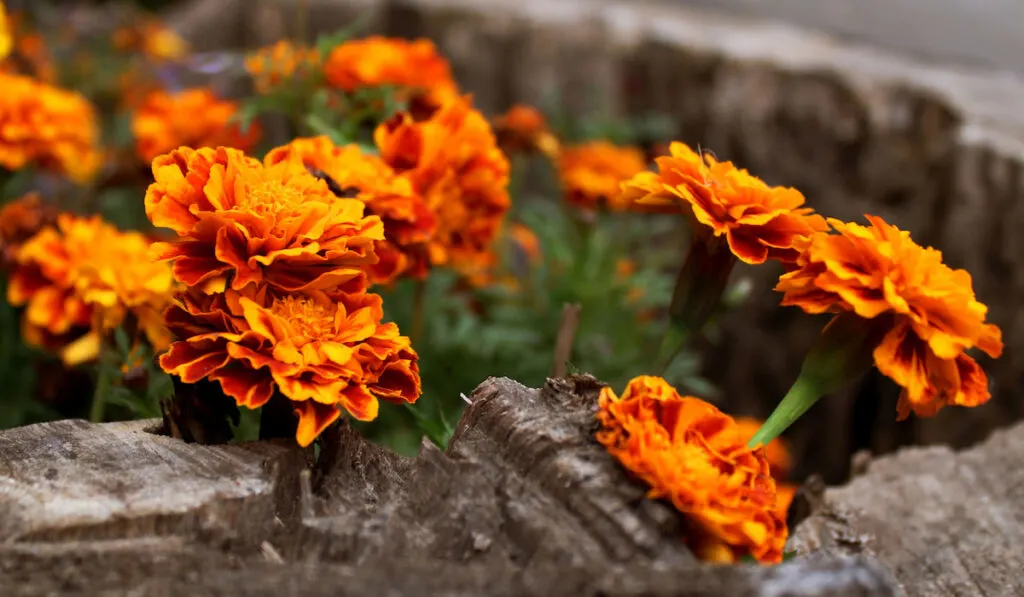
Carnations come in several colors, including orange, pink, purple, yellow, and white. They have ruffled, upward-facing petals that grow on long narrow stems.
Due to their fragrance and beauty, Carnations are popular cut flowers. They are popular among florists and are often arranged with baby breaths.
Carnation flowers are quite symbolic, as they represent bravery, motherhood, peace, and gratitude. They thrive best in moist, well-drained soil.
To ensure the plant gets adequate moisture, plant it in soil that is rich in organic matter. Also, ensure it is exposed to full sunlight.
Carnations grow best in zones 5-9.
Canna

Although this plant goes by the common name Canna Lily, it is not an actual lily.
Cannas produce attractive blooms that are similar to Lilies. They have large paddle-shaped leaves and flowers of several colors, including orange, red, cream, yellow, and pink.
To grow Cannas successfully, provide rich, moist, well-drained soil. Also, ensure they get full sun. Cannas develop well when they get a regular water supply. However, once they become accustomed to their environment, they need very little care.
Cannas grow best in zones 8-11.
Chrysanthemum
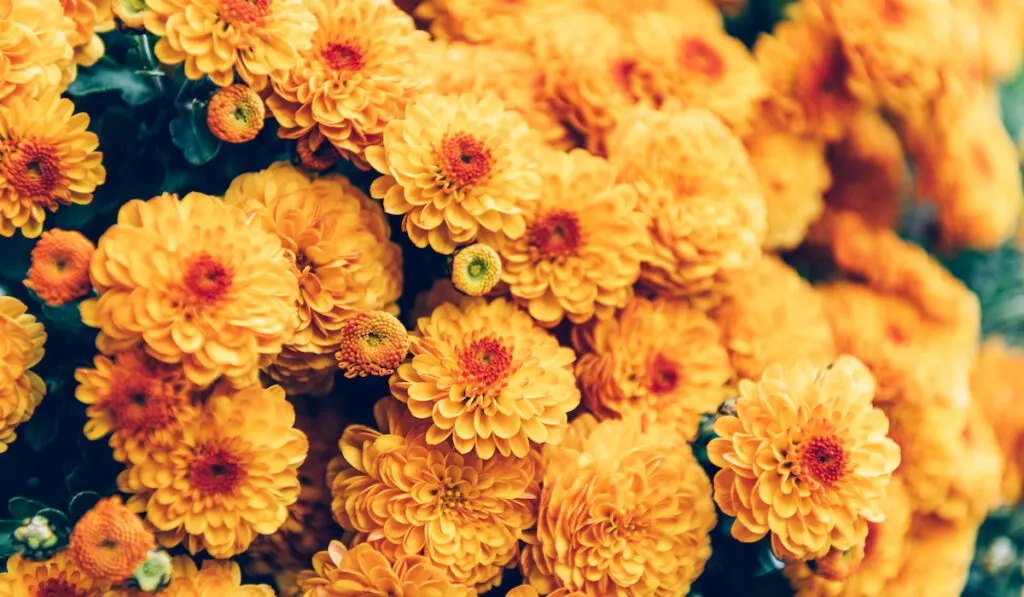
Chrysanthemums are perennials with almost symmetrical bloom patterns. They are also called garden mums.
Chrysanthemums start blooming from late summer or early fall, producing orange, red, gold, purple, yellow, and bronze flowers. Some popular orange cultivars include Miranda orange and Dixter orange.
Orange Chrysanthemum is the official flower of November and is used as décor in containers. You can also gift this flower to someone who needs cheering up. Orange Chrysanthemums can also function as natural insect repellents.
Orange Chrysanthemums grow best in rich, moist, well-drained soil and full sun. To get bushier growth, pinch back the main stems of the plants.
Orange Chrysanthemum does best in zones 5-9.
Cosmos

If you are looking for a statement flower, look no further than Cosmos flowers. They are attractive and low-maintenance annuals that produce bowl-shaped flowers on long stems.
Some common orange cultivars of Cosmos are ‘Bright Lights’ and ‘Cosmic Orange.’
Cosmos are excellent for cut flowers and centerpieces placed near entrances due to their sweet scent. The blooms attract hummingbirds, bees, and butterflies to your garden. So, they can be the perfect companion plants for some other plants.
Cosmos will thrive in well-drained soil with full sun. When flowers begin to fade, remove them to encourage prolonged blooming.
Cosmos grow best in zones 3-10.
Cymbidium Orchids
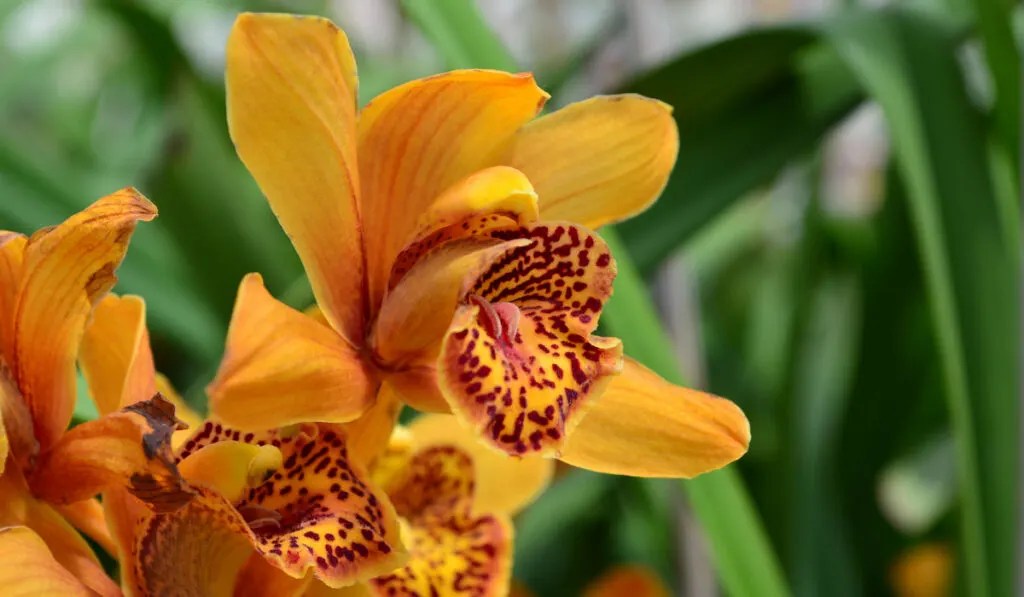
Cymbidium orchids or boat orchids are famous for their long-lasting blooms that come in a variety of colors. When they blossom, each stem can have as many as 15 flowers or more.
Cymbidium orchids are popular among beginners because they are easy to grow and can tolerate different climates.
Cymbidium orchids require well-drained soil and full sun or partial shade to grow successfully. Avoid exposing this plant to freezing temperatures and hot mid-day sun.
You can incorporate an orange orchid in your floral arrangement to symbolize boldness and pride.
Although orchids are generally complicated to care for, Cymbidium orchids are considered one of the trouble-free varieties. They grow best in zones 5-10.
Dahlias
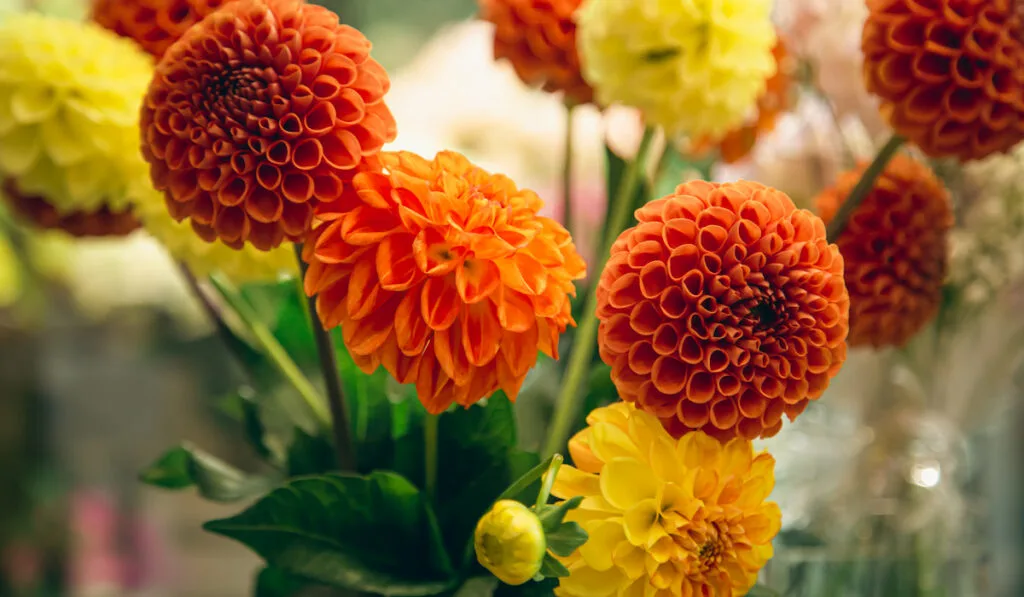
Dahlias are unique flowers with large, round heads and spiky petals. These attractive flowers appear in a variety of sizes and colors. Dahlias can grow to around 6 feet tall, making them perfect for statement centerpieces.
The ideal planting condition for Dahlias includes moist, well-drained soil and full sun. Dahlias do not need too much water until the flowers are established.
Dahlias will not thrive in cold soil. So before planting, ensure the ground temperature is about 60 degrees or more.
Dahlias grow best in zones 8-10.
Iris
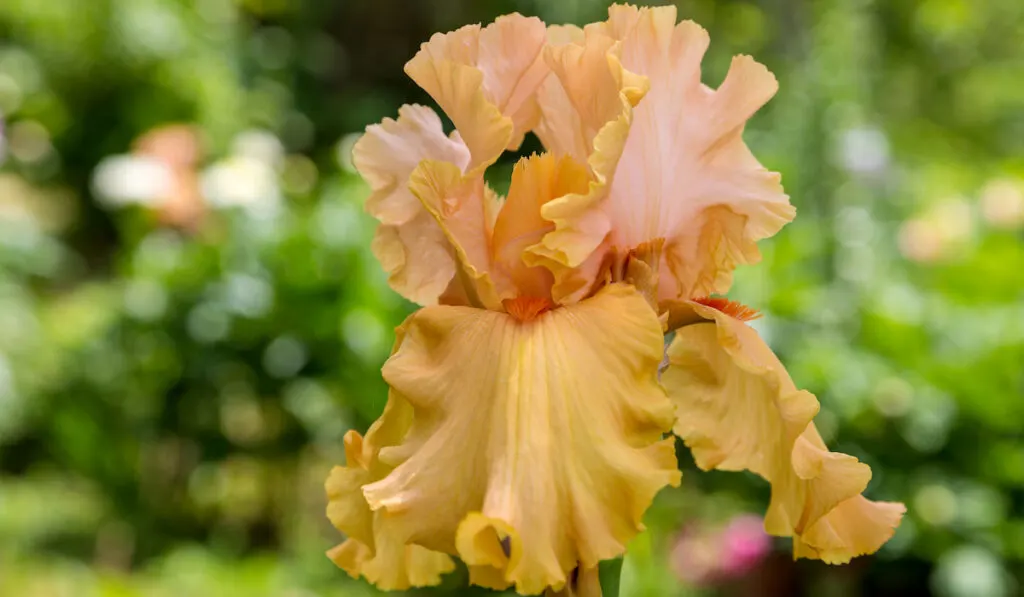
Iris flowers have delicate-looking blooms that come in various shades of orange, purple, yellow, blue, and white. They come with two sets of petals, 3 upright and 3 that droop. Many times, the color of the upright petals differs from those of the drooping ones.
Some orange Iris cultivars include ‘Acapulco Gold,’ ‘Maiden Orange,’ and ‘Grand Canyon Sunset.’ You can plant Iris in your garden to attract birds or put them in containers.
Irises thrive in rich, moist, well-drained soil with full sun. They also need regular but moderate watering. Some Iris varieties prefer acidic soil, while others prefer alkaline soils. So always do a soil check before planting.
Irises are hardy in zones 3-9.
Lantana

Lantana plants produce tiny, bright blooms that appear in several colors, including orange, purple, red, yellow, and white. They have oval, dark-green leaves that have a wrinkled texture.
Lantana is a low-maintenance tropical plant that grows well in hot, dry areas and is perfect for containers. The ideal planting conditions for this plant include well-drained soil and full sun.
You should only grow Lantanas outdoor if you live in a frost-free zone or they may suffer diseases, and flower production may decline.
Lantanas are best grown in zones 2-11.
Lion’s Tail
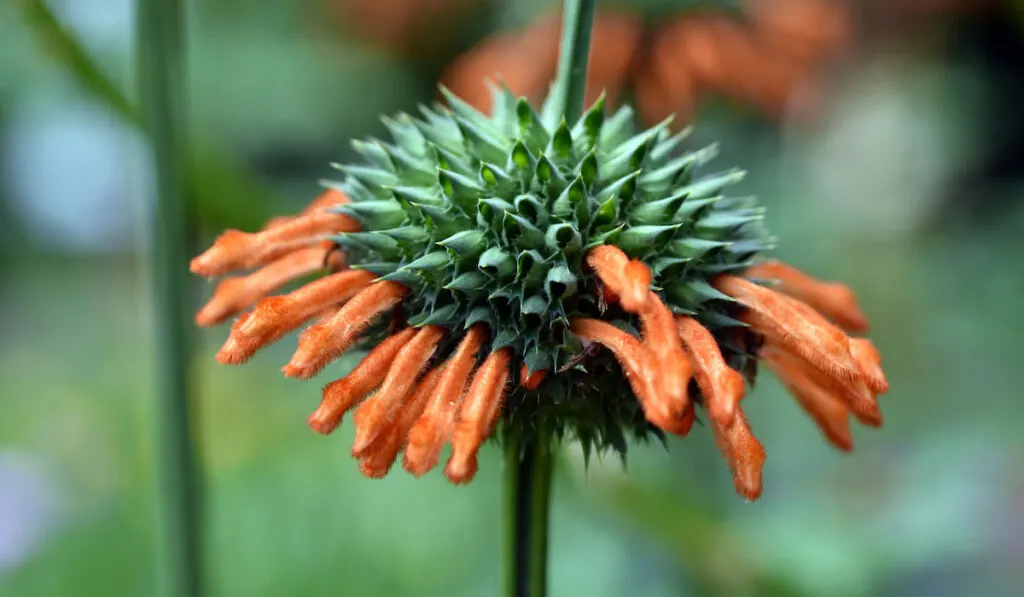
Lion’s Tail is a tall perennial that will give the garden that exotic flair you have always wanted. Its tiny and bright orange flowers can add a splash of color to any garden. The flowers cluster on slender spines with sharp thorns.
Lion’s Tail thrives in well-drained soil with full sun. It also requires minimal watering and does best in zones 8-11.
Lion’s Tail can tolerate drought and is excellent for xeriscaping. Ensure you wear gloves when handling to avoid getting pierced by sharp thorns.
Marigold

Marigold flowers come in various bright colors, including orange, red, yellow, and bicolor. The flower and foliage of this popular annual have a frilly and alluring fragrance.
Marigold flowers symbolize joy. They are excellent for decorating outdoor events and can also act as a natural insect repellent. Marigolds also have medical applications since they contain some essential oils that can heal rashes.
Although they can grow in almost any soil, Marigolds thrive best in moist, well-drained soil with full sunlight. So, if you live in an area with enough sunlight, this plant is perfect for you.
When you water marigold plants, water from the base rather than the head. Avoid overwatering and ensure the soil is dry before you water again.
Young marigold plants should be pinched to encourage bushier growth.
Marigolds grow best in zones 2-11.
Ranunculus

Ranunculi are famous for their brightly colored flowers, tall stems, and ruffled petals.
Ranunculi are also known as Buttercups, and they symbolize attractiveness and charm. Their brightly colored flowers make them a favorite for engagements, weddings, and florist shops. Ranunculus also have a long vase life, which makes them excellent cut flowers.
Ranunculi are fast growers, and they thrive in moist, well-drained soil. They prefer areas with at least six hours of full sun. Ranunculus plants do not require too much watering. You can water them once a week until fall.
Avoid removing the foliage until it turns yellow at the end of summer. Green foliage helps the plant gather sunlight for the next gardening season.
Ranunculus grows well in zones 8-11.
Zinnias
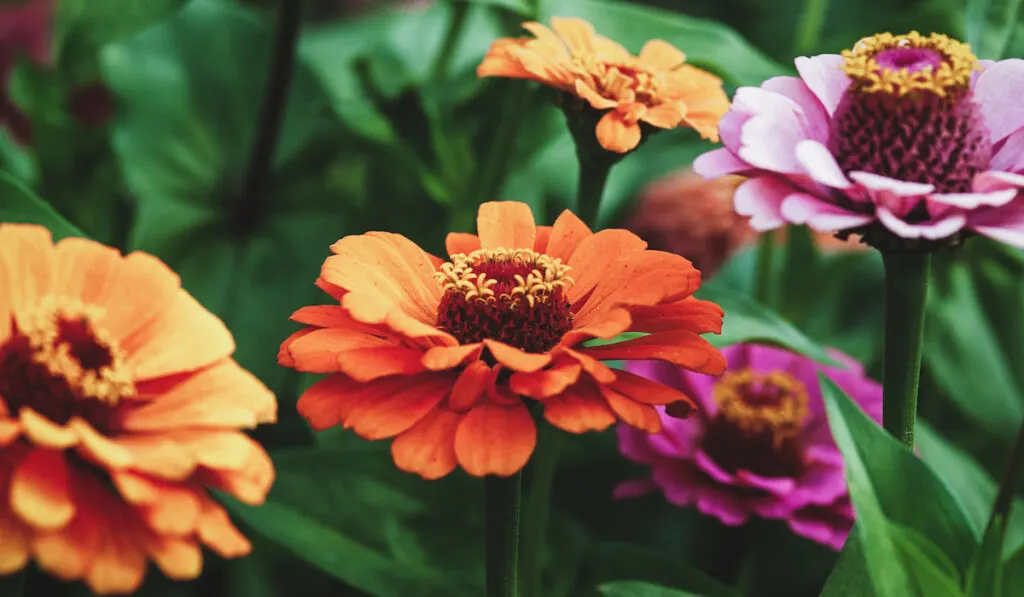
Zinnias are popular annuals with bright blooms that come in a variety of colors except brown and blue. Some common orange cultivars include ‘Queeny Lime Orange,’ ‘Orange King,’ and ‘Zinderella Peach.’
Zinnia flowers grow on tall, slender stems that grow to around 3 feet. They are easy to grow and symbolize lasting affection.
Zinnias are perfect for gardens, decorating anniversary parties, and fall bouquets. They attract butterflies, hummingbirds and are famous for being long bloomers with significant resistance to cold.
Zinnias grow best in rich, humid, well-drained soil with full sun. When blooms fade, remove them to promote continuous flowering.
Zinnias are hardy in zones 2-11.
Resources:
- https://www.ftd.com/blog/design/orange-flowers
- https://balconygardenweb.com/types-of-orange-flowers-names
- https://www.homestratosphere.com/orange-flowers
- https://www.proflowers.com/blog/orange-flowers
- https://farmfoodfamily.com/orange-flowers
- https://www.thespruce.com/pictures-of-orange-flowers
- https://www.flowerglossary.com/orange-flowers
- https://www.eathappyproject.com/types-of-orange-flowers-stunning-orange-flowering-plants
